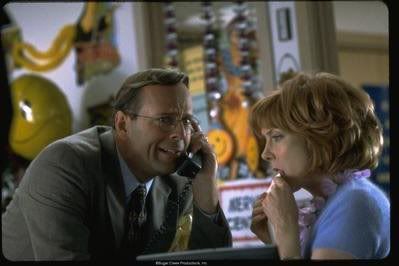I have heard this plenty of times, and in my experience, it seems that most folks who have seen a movie based on a book that they have read prefer the book to the movie. But why do people feel this way? Is there more information included in the book that can’t fit into two hours (or more… Hollywood is digging the epics these days…) of screen time? Shouldn’t the movie, as a mostly visual medium, suck the viewer into the story world with more efficiency? Are words on a page more powerful or compelling than the combination of images on a screen and audio out of speakers?
To understand these questions, let’s take a look at two different movies adapted from books. Here in Part 1 of this two-part blog, we will take arms with the bookworms and look at Breakfast of Champions, a great book, but a teeeeerible movie.
Breakfast of Champions is a book written by Kurt Vonnegut Jr. in 1973, and adapted into a movie by Alan Rudolph (director/screenplay) bearing the same name in 1999. The book and the movie share the same plot (don’t laugh, some adaptations do not share the same plot): Dwayne Hoover (played terribly by Bruce Willis) is a successful used car salesman in Mid-West America who is on the brink of insanity when the writings of a visiting science fiction writer, Kilgore Trout (played by Albert Finney), push him to violent madness.

The movie does a decent job of handling the ensuing craziness of one of the main characters, Dwayne Hoover. The shots of this character “going insane” include overlays of some kind of lava lamp effect, unconventional camera angles, and audio of voices that appear to be in his head. However, Bruce Willis was a terrible choice for the role because of his history of being typecast in the role of an action hero. I kept waiting for him to blow something up or look sternly off camera… But let’s take a look at how the movie compares to the book.
The first thing a viewer will notice about Breakfast of Champions that differs from the book is that the movie is missing the crude illustrations that Vonnegut includes in his book. In the preface for his book, Vonnegut plainly spells out his motivation: “This book is my fiftieth-birthday present to myself… I am programmed at fifty to perform childishly – to insult the ‘Star-Spangled Banner,’ to scrawl pictures of a flag and a asshole and a lot of other things with a felt tipped pen” (Vonnegut, 4-5).

Vonnegut’s crude and simple drawings add to the satire and humor of his book and Rudolph neglected to somehow incorporate this into his film (granted, this would be tough… overlays of felt-tip pen drawings on different shots? nah…). However, the biggest gap between the book and the movie is the lack of narrative voice. In this book, Vonnegut claims to be trying to “clear [his] head of all the junk in there… trying to make [his] head as empty as it was when [he] was born onto this damaged planet fifty years ago” (Vonnegut, 5). So, in the book (like all of his books), Vonnegut has the undeniable narrative authority; the reader is always clear that this is Vonnegut’s story, and that he is telling it. In Rudolph’s movie adaptation, there is no narration. Granted, this is easier when the narrator of a story happens to be a main character in the story (read/see these successful book/movies: No Country for Old Men, Fear and Loathing in Las Vegas).
So books with a strong author-based narrative voice may not make good movies because this narration has no place in film except as a voice-over narration, which could be hard to explain to viewers when that voice does not belong to a character in the story. However, this does not mean that all books tell better stories than all films. In the next blog, we will take a look at how a movie can outdo a book in storytelling.
print credits: Vonnegut, Kurt. Breakfast of Champions. New York: Random House, 1973.
photo credits:
1)https://blogger.googleusercontent.com/img/b/R29vZ2xl/AVvXsEiUa2l9bCXC0t6LhmQ8Cihx01IsNrxEtfObKCd8JcfrhSzdDy3xnXMtJIUUGjPCJIcXxmLtPaAi7EqTo-Bfvv8__fDlG2X72Kg0ZpCBicorJcfjoMNUzxU_-QBatEF1_M3xMtGu7HwdFdE/s400/Breakfast+of+Champions+%233.jpg
2) https://blogger.googleusercontent.com/img/b/R29vZ2xl/AVvXsEiUg1W-t6LtLVF1Fc6eyuW5YmnAQrgc3d9kyWZ0cuBof14wAOyMpgvRaSTP6afh65cvsTFmaxe8DfjaTCyztMObaSCyhMfjF6PGUVJIWvOIWCu5t8DvOHcZEgXaY6nvpiE6WwA-MIJg/s400/vonnegutchart.jpg)